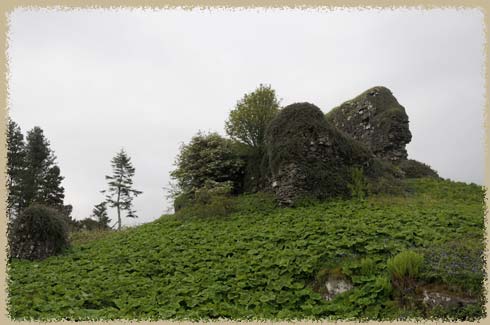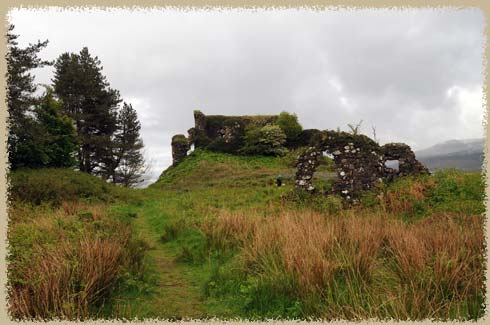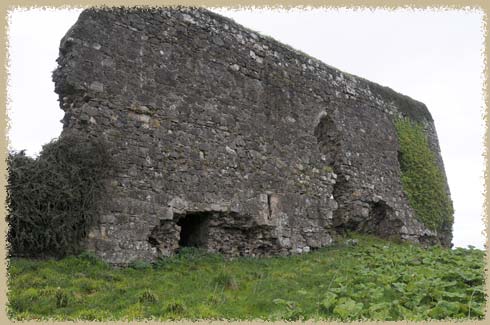Aros Mains Castle
The way to Tobermory, on the Isle of Mull, is a winding narrow road that passes right by the ruin of Aros Castle. The castle is in a private yard (make sure to park to the side of the driveway), but is an open site. A modern house stands nearby, and the owners have posted signs warning that the ruins are dangerous that they take no responsbility for any injury. There are steep drops on the site, and with all the greenery, they are hard to see - I nearly pitched myself down the hill when I missed a step and slid on the wet ground. Be careful! It's a long way down to the water.

the mostly-buied tower house of aros on the ivy-covered hill
Most important castle on Mull
The ruins here seem awfully small to be considered the most important site on Mull, but it held a prime position on the coast and was one of the string of castles along the island, meant to control both sides of this critical sea access.

lookup up the hillside from the road
The tower here dates from the 13th century, with a keep and courtyard. THe hillock is entirely covered in ivy and flowers (and snails! don't forget the snails!). It falls off steeply to the beach, and a deep ditch protected the landward side (probaby with a drawbridge). The hill is not that tall, actually (only about 15m), but it stands out as a notable landmark from the Sound of Mull.
The courtyard original meausured 70m x 45m (about half an acre)-- although it's hard to see even the foundations under all the rubble and ivy. The stumpy ruins are of the 13th century tower with 3m thick walls. The upper floor has thinner walls, and rises to a height of about 10m to a wall walk (unaccessible without climbing gear, I think). Only a small part of the curtain wall remains on the west and south, but is only a couple of feet tall -- quarrying has removed it altogether in some places. There are the remains of at least five other buildings on the hilltop to the southwest, mostly just grass-covered mounds.

the remaining wall of the 13th century keep
The lower floor has two separate entrances into two rooms, athough they are hard to make out without any floors and only a few walls standing. The upper floors would have been reached by an external staircase, psosibly in the curtain wall, and probably contained the main hall and a private room on the northern end -- the remains of two large windows attest to the importance of the room.
Ownership
The keep was bulit by the MacDougals of Lorn, but by the 14th century had passed to the Lords of the Idles, the Macdonalds after the MacDougals were forefeited to Robert Bruce. It became the main seat of the Lords of the Isles, hence it's esteemed position. Three charters were issues by the Lords here at Aros Mains in 1410,1469, and 1492. Shortly thereafter, the family was forfeited and in 1493 the castle came to the hands of the MacLeans of Duart (of Duart Castle, to the south).
A court was held here for James VI in 1608 by Lord Ochiltree -- who managed to capture and improsion many of the local chiefs, and the castle was returned to the MacLeans. About this time, the castle was "not worth maintaining", bsed on a report by Ochiltree to the council.
Both Duart Castle and Aros were occupied by the Campbell Earl of Argyll in 1674 (taken by force, it seems, from the MacLeans to"punish" them - although it took two thousand men to do it). Afterwards, the lands passed to the Campbells, although in 1688 it was considered useless and ruinous. By the 18th century the tower had ceased to be an important stronghold and power had moved to Tobermorey.

